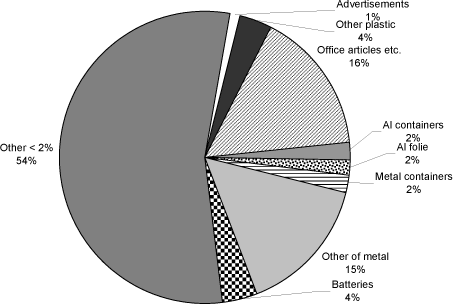|
| Forside | | Indhold | | Forrige | | Næste |
Måling af tungmetaller i dansk dagrenovation og småt brændbart
Summary and conclusions
Focusing on pollution prevention from waste incineration and landfilling, new technologies have been developed and implemented during the past 30 years. Pollution has therefore reached a level where the
efforts and economy required to ensure further pollution prevention open up for new approaches. One method is to ensure correct treatment of each type or fraction of waste. To do this, detailed knowledge
of the individual waste types and waste fractions must be obtained, paying special attention to the content of hazardous components. Knowledge about contributions to the overall pollution from individual
waste types and fractions is important in order to prioritise. With this combined knowledge, it is possible to optimise the treatment and/or isolate specific harmful fractions for dedicated treatment of these
fractions. The aim of this project was to provide such knowledge and determine the consequences to the bottom ash from incineration of the waste
Investigations
Waste was analysed by two approaches: incineration of the waste at a full-scale incinerator with subsequent analysis of the outputs (indirect analysis), and sorting of the waste into multiple fractions for
chemical analysis (direct analysis). The work was performed by Ph.D. student Christian Riber in collaboration with Professor Thomas H. Christensen, both from the Institute of Environment & Resources at
the Technical University of Denmark. The project was financed by the Danish Environmental Protection Agency, the NGO affald danmark, the municipality of Herning, and the Institute of Environment &
Resources.
Main conclusions
Increasing efforts to source-separate hazardous and other problematic fractions from household waste are proved to result in less heavy metals sent to incineration. On the other hand, it is concluded that
collection system differences, such as size or ownership of the waste bin, is not systematically affecting the waste chemical composition.
The chemical composition of waste from other sources than private households was calculated, and the contribution to the total amount of waste incinerated was determined. This calculation suggests that
non-private waste was the main contributor of cadmium, cupper, lead, zinc, chloride and manganese.
Direct measurement of 45 material fractions of Danish household waste lead to the following conclusions:
- Cadmium, manganese, nickel, zinc and mercury originated from batteries and hazardous waste.
- Arsenic, cupper and mercury originated from other metal fractions than cans and foils.
- Chromium was mainly found in shoes, leather and textiles.
The majority of the heavy metals can be removed from the household waste as fractions that are not suitable for incineration. If chromium is unwanted in the incinerators, fractions like leather and textile
should be separated from the waste.
Project results
By incinerating waste in a full-scale incineration plant, the chemical composition of the waste can be determined by summation of the chemical compositions of the outputs from the incinerator. This approach
is termed "indirect analysis", because the waste is not analysed directly, but instead analysed indirectly based on outputs from three Danish incineration plants. The wastes analysed were household waste,
mixed municipal waste and combustible (<1 m) waste from a central collection facility. With data from the indirect analysis, the composition of the non-private waste was calculated as shown in Table A.
Table A Content of some heavy metals in Danish household waste, combustible and non-private waste
| |
Combustible |
Household |
Non-private |
| Arsenic |
17.9 |
7,44 |
21 |
| Cadmium |
13.8 |
5,67 |
13 |
| Chromium |
275 |
109 |
77 |
| Cupper |
2640 |
698 |
700 |
| Mercury |
3.02 |
2,56 |
- |
| Lead |
879 |
299 |
580 |
| Zinc |
2860 |
1290 |
1700 |
Unit: mg/kg dry waste.
In a former project from the Danish EPA (report no. 868 from 2003), household waste was sorted in 45 fractions, and the mass fractions were determined. In this project, these fractions were sampled and
the chemical composition was analysed. New methods of analysis and handling had to be developed to be able to analyse the 45 very different waste fractions. The methods for analysis of waste split into
fractions (direct analysis) were developed and tested.

Figure A. Distribution of cupper among the 45 fractions sorted out of Danish household waste (fractions contributing <2% are summarised)The following types of parameters were determined with respect to the 45 fractions:
- 24 elements
- phthalates
- heating value
- water and ash content
Figure A shows an example of cupper distribution among the 45 fractions (fractions contributing less than 2% are summarised). Some inconsistencies were recorded between the composition of household
waste measured by the direct and the indirect method. This was especially true for substances in trace concentrations. These differences were assumed to result from over or under-representation in the
direct analysis.
| Forside | | Indhold | | Forrige | | Næste | | Top |
Version 1.0 Maj 2006, © Miljøstyrelsen.
|